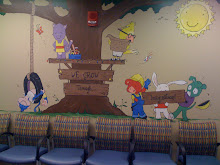As fall settles in, certain viruses become more prevalent. Hand Foot and Mouth Disease is one of these viruses. It can affect any age but seems to have a preference for toddlers and preschool age children. It usually starts out with low grade fever 100-101 and a sore throat. A pre-verbal child is most likely to present with fussiness, crankiness and decreased appetite. The mouth sores usually develop either at the same time as the fever or shortly thereafter and then a distinctive rash develops. The palms and soles are affected with small red blisters. Sometimes there can also be a more generalized body rash as well.
As with most viruses, this one needs time to run its course. Supportive measures are recommended such as increased fluids and pain control. It usually takes about a week to resolve. Children are considered contagious until the blisters have begun to fade. Contact your child’s doctor if the fever persists beyond three days or if your child is not eating, drinking or making urine.
Friday, October 8, 2010
SIDS Awareness Month
October is SIDS awareness month.
(1) Put your Baby on her back to sleep for every sleep even naps. Even side sleeping has been shown to increase the risk of SIDS
(2) Make sure that your infant's bed is clear of all extra objects. Only the crib, mattress and a fitted sheet are appropriate. No quilts, stuffed animals, bumpers or pillows.
(3) Do not over bundle your infant.
(4) Do not smoke around your infant or allow anyone else to smoke around your infant.
(5) Do not cosleep with your infant. By all means nurse, cuddle and comfort your infant but when it is time for sleep, your baby should be in a basinette or crib.
(6) It is appropriate for to room share for the first 6 months but again your baby should be in his own bed next to your bed.
(7) Consider using a pacifier after breast feeding is well established. Studies have shown that using a pacifier for sleep prevents the infant from falling too deeply asleep.
(8) Keep the room temperature comfortable. The room should feel comfortable to you. It is okay to use a ceiling fan to help achieve comfortable temperatures and to promote air circulation.
(9) Only put your baby on a safety approved mattress. NO water beds. NO couches. NO sofa beds.
(10) Do not use sleep positioners. They have caused infant deaths due to suffocation and have been warned against by the FDA and consumer product safety commission.
Remember to talk to your doctor if you have questions about reducing your infant's risk for SIDS.
Here are 10 simple steps to reduce your baby's riskSIDS stands for Sudden Infant Death syndrome. All infants under the age of one year are at risk. This is a difficult topic to broach with parents because it evokes fear, anxiety and sadness. However just a few simple steps can dramatically reduce the risk of SIDS
(1) Put your Baby on her back to sleep for every sleep even naps. Even side sleeping has been shown to increase the risk of SIDS
(2) Make sure that your infant's bed is clear of all extra objects. Only the crib, mattress and a fitted sheet are appropriate. No quilts, stuffed animals, bumpers or pillows.
(3) Do not over bundle your infant.
(4) Do not smoke around your infant or allow anyone else to smoke around your infant.
(5) Do not cosleep with your infant. By all means nurse, cuddle and comfort your infant but when it is time for sleep, your baby should be in a basinette or crib.
(6) It is appropriate for to room share for the first 6 months but again your baby should be in his own bed next to your bed.
(7) Consider using a pacifier after breast feeding is well established. Studies have shown that using a pacifier for sleep prevents the infant from falling too deeply asleep.
(8) Keep the room temperature comfortable. The room should feel comfortable to you. It is okay to use a ceiling fan to help achieve comfortable temperatures and to promote air circulation.
(9) Only put your baby on a safety approved mattress. NO water beds. NO couches. NO sofa beds.
(10) Do not use sleep positioners. They have caused infant deaths due to suffocation and have been warned against by the FDA and consumer product safety commission.
Remember to talk to your doctor if you have questions about reducing your infant's risk for SIDS.
Subscribe to:
Posts (Atom)


